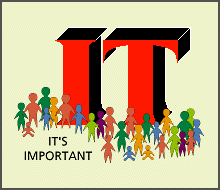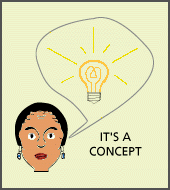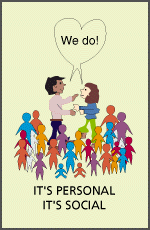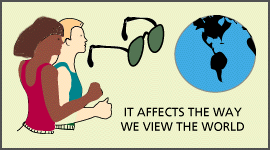
 TUTORIAL: Communication Environment
TUTORIAL: Communication EnvironmentINTRODUCTION . THE COMMUNICATION ENVIRONMENT . COMMUNICATION AND CULTURE . THE SOCIAL CONSTRUCTION OF REALITY . IDEOLOGY . TECHNOLOGY
A group of people who share an ideology share a common set of ideas as to what the world is like. We have already seen that all human groups evolve patterns of behavior - institutions and roles - that become real to them, so it should come as no surprise that a group of people who share an ideology might construct a social reality that fits their beliefs.
Those who study ideological behavior point out that most societies have a group of beliefs that the majority of the members of the society share. This is called the dominant ideology of the society.
An ideology is a prescription for a way of life. Every society displays a general or 'dominant' ideology: a code of general values most of its people share, consciously and unconsciously, and within which various group and individual ideologies arise.
The task of a general ideology is to explain the past, the present, and the expected future of the system one is in, whether fully, reliably, usable or not. Imaginary ideologies invariably include enough elements of truth to be plausible to most people most of the time, however implausibly these elements may be interpreted and arranged.
- Wilden 91
In terms of the Berger-Luckmann model of the social construction of reality, ideologies serve to legitimize a society's institutions. Americans, for example, have an ideological belief in their right to "throw out" the current government should such action become necessary. This belief helps legitimize the institution we call the "press," which has as one of its functions the task of keeping a close watch on the government and telling everyone "what is going on." In our schools we contribute to this legitimation by teaching about situations such as the Watergate Hearings in which the press played a major role in bringing government impropriety to light.
Ideologies are by nature symbolic: what they symbolize may be both imaginary and real, reality being the ultimate test of their validity. They are transmitted between people by every available means: ritual, schooling, clothing, religion, jokes, games, myths, gestures, ornaments, entertainment.
- Wilden 91
Because ideologies are so closely tied to reality, and because they are concepts, they form an important part of our communication environment. As with institutions, they manifest themselves as rules, but whereas institutions constrain our behavior and actions, ideologies constrain our thoughts and speech.
![]() 1524
1524
Taken together, these characteristics define an environment that operates as a set of rules, that is, ideologies act as constraints on the behavior of the social system. By encouraging certain expressions and discouraging others, and because they act at the level of concepts, ideologies put constraints on communication. Brown's criteria will be examined in detail next.
 Members of an ideology may hold beliefs that members of different ideologies others find silly, inconvenient, or even hateful. However, to the member of the ideology these beliefs are part of reality, and are therefore, by definition, true.
Members of an ideology may hold beliefs that members of different ideologies others find silly, inconvenient, or even hateful. However, to the member of the ideology these beliefs are part of reality, and are therefore, by definition, true.
The theory of the social construction of reality argues that roles develop within institutions. One of the things that makes ideologies powerful is that by giving answers to important questions, they help define these institutional roles. Thus, within a society with an unchallenged dominant ideology "everybody knows their place" and there is no need to question rules or roles.
However, most societies contain a mix of ideologies. These are often catagorized into three types: dominant, subordinate and radical.
 For example, the wars of the Protestant Reformation in Europe were fought between two strongly ideological groups, the Protestant Christians and the Roman Catholic Christians. Although the two groups shared many beliefs and customs, they took opposing positions on certain concepts, and when these two groups with their different realities tried to share the same space, the result was a bloody and devastating war.
For example, the wars of the Protestant Reformation in Europe were fought between two strongly ideological groups, the Protestant Christians and the Roman Catholic Christians. Although the two groups shared many beliefs and customs, they took opposing positions on certain concepts, and when these two groups with their different realities tried to share the same space, the result was a bloody and devastating war.
This aspect of ideology is especially visible in mass communication. Newspapers and magazines which are owned by individuals or groups who subscribe to a particular ideology often adjust the content of their messages accordingly. The same news event may be described very differently in a "liberal" as opposed to a "conservative" newspaper. Or some television stations may put restrictions on the types of shows that they will allow on the air. Campaigns to remove "sex," "violence," "drugs," "crime" and other themes from the mass media, or to add themes relating to various races, classes and genders are examples of action based on ideological commitment.
![]() Patriarchy
Patriarchy
 current debate on abortion in the United States. One side argues in favor of the idea that it is wrong for one human being to kill another, and one side argues in favor of the idea that it is wrong for the government to interfere in the personal lives of its citizens.
current debate on abortion in the United States. One side argues in favor of the idea that it is wrong for one human being to kill another, and one side argues in favor of the idea that it is wrong for the government to interfere in the personal lives of its citizens.
The legal institutions of the United States have grown from the Declaration of Independence and the Constitution.
These institutions promise "life, liberty and the pursuit of happiness." In the abortion debate one group argues for liberty; the other for life. Thus, both of these groups represent dominant ideologies in U.S. society. In this particular situation these two ideologies are in conflict, and this produces the great argument on the subject.
"Life" and "liberty" are concepts -- which is to say that no uniformly accepted, exact definition of either exists. Thus, these two ideologies assert different social realities, and this is one of the reasons why the debate seems to continue endlessly without resolution.
![]() Patriarchy
Patriarchy
 the group. But ideologies manifest themselves in the actions of individuals.
the group. But ideologies manifest themselves in the actions of individuals.
In terms of the "abortion" example introduced above, women who have abortions are acting personally, as are the people who sit on the street in front of health care centers that perform abortions, as are the lawyers who donate their time to litigate court cases that apply to abortion, and so on.
An ideology, therefore, is not something abstract, such as "the government in Washington," or "the economy," or "the educational system." Ideology occurs within people's own minds and affects their day-to-day lives. And, as it is the habits that people develop in their day-to-day living that eventually become a society's reified institutions and roles, ideologies thus play a significant part in the social construction of reality.
![]() Patriarchy
Patriarchy
An ideology is a social phenomenon - that is, it is a collection of beliefs that are shared by the members of a group. When one group shares a set of ideas about the ideology of another group, that is, a belief about a set of beliefs, stereotypes may develop.

Unfortunately, when people stereotype ideologies of which they are ignorant, they often focus on the most negative characteristics. Nonetheless, stereotypes are not always bad. In fact they are closely related to the roles that are associates with social institutions, and they play an important part in the social construction of reality.
In general, it is useful to stereotype police officers as being honest, fire fighters as being courageous, mail carriers as being dedicated, and so on because these stereotypes allow us to predict the behavior of others as we "make sense" of the social world in which we live. Once we have stereotyped a person or group, however, we usually find it difficult to treat them as "regular" individuals.
![]() Patriarchy
Patriarchy
![]() 1504
1504
![]() 1507
1507
![]() 1508
1508
![]() 1509
1509
![]() 1510
1510
![]() 1521
1521
![]() 1522
1522
![]() 1552
1552